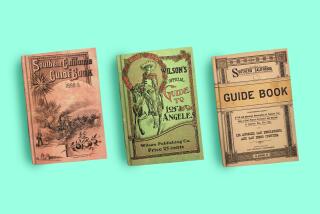Clifton Hillegass; Built Cliffs Notes Into Multimillion-Dollar Business
- Share via
It was the best of times, it was the worst of times.
--Charles Dickens, “A Tale of Two Cities”
In 1775, people viewed their era as exceptionally good or exceptionally wicked.
--Cliffs Notes version of same
*
Clifton K. Hillegass, the innovative Cliff who founded the familiar yellow-and-black study guides called “Cliffs Notes” to help high school and college literature students cram or just plain fake it, has died at the age of 83.
Hillegass, who founded the unusual publishing company with a $4,000 loan in 1958 and sold it for $14 million in 1999, died Saturday in Lincoln, Neb., of complications from a stroke he suffered last month.
His Cliffs Notes, according to a Forbes magazine report in 1989, could be considered “the ideal publishing company” from a business standpoint. Hillegass’ little niche organization, after all, paid modest fees to its writers and no royalties, printed booklets for pennies a copy and enjoyed a minuscule 6% return rate from stores.
By the time Hillegass sold the company to IDG Books Worldwide Inc. of Foster City, Calif., Cliffs Notes was selling more than 5 million pamphlets annually and reaping multimillion-dollar profits.
Not bad for a guy who entered the book trade as a $12-a-week clerk in a campus bookstore.
Born in the Nebraska hamlet of Rising City, the son of a rural mail carrier, Hillegass earned a bachelor’s degree in physics and math at Midland Lutheran College and began graduate studies in physics and geology at the University of Nebraska. But, dropping out to get married in 1939, he jumped at the chance to sell books at the little shop with the ambitious name of Nebraska Book Co.
After serving as an Army Air Corps meteorologist during World War II, Hillegass returned to Nebraska Book but with new duties--crisscrossing the United States to buy and sell used college textbooks.
Cliffs Notes sprang from a serendipitous buying trip to Toronto when Jack Cole invited Hillegass home to dinner. Cole, who operated two bookstores and published a series of course outlines in Canada called Cole’s Notes, suggested Hillegass distribute his condensations of 16 Shakespeare plays for sale in the U.S.
“In the Midwest, in those days, there was probably nothing worse than to go bankrupt,” Hillegass the math major later recalled. “But I had it sketched out that if I continued with my job, and the Notes bombed, I could pay all the bills in 20 months.”
So with the $4,000 bank loan and 120-day terms from his friend Lowell Boomer, of Boomer’s Printing Co. in Lincoln, Neb., he printed the first 33,000 copies. Setting up a shipping department in the basement of his Lincoln home and marketing to bookstore owners he knew so well, Hillegass shipped the first batch of Cliffs Notes in August 1958. By year’s end he had sold 58,000 copies.
Hillegass designed the cover of the bright Cliffs Notes books, complete with a visual pun of an outline of mountain cliffs. But he never wrote any of the guides he sold, instead experimenting with hiring various literature teachers to condense the great works into concise summaries, commentaries, author biographies and character analyses.
“Someone involved in 20 years of teaching Shakespeare,” he told an interviewer after several years of trial and error, “often has too specialized a knowledge. Eventually we found that the best Notes were written by graduate students.”
After his own stable of writers revised Cliffs Notes summaries of the Shakespearean plays, Hillegass phased out the Cole’s versions in the 1960s, after paying modest royalties for the first few years to his Canadian business muse.
Although Hillegass voraciously read mysteries and science fiction, he never let his own taste interfere with business. When George Orwell’s “1984” stopped selling in 1985, he pulled the title off the market.
He knew his market and played to it, changing titles as literature teachers’ emphasis shifted. Seventy percent of buyers have been high school students too rushed, bored or lazy to read the whole of, say, “The Scarlet Letter,” “Macbeth” or “Huckleberry Finn,” all top sellers. Among other lucrative Cliffs Notes have been shorthand versions of “Julius Caesar,” “Hamlet,” “The Great Gatsby,” “Lord of the Flies,” “To Kill a Mockingbird” and “Romeo and Juliet.”
By advertising regularly in such youth magazines as Seventeen and Scholastic and college newspapers, Hillegass over the years trounced upstart competitors, controlling 80% of the literary study guide market. Not that he didn’t have a few missteps--like Cliffs Cassettes, an attempt to put the guides into students’ Walkmans. He marketed audio guides to “Othello,” “Canterbury Tales” and “The Odyssey,” but withdrew them as poor sellers after only six months.
An avuncular, Buddah-like figure who wore bolo ties and liked to sit in the press box at the University of Nebraska Cornhuskers’ home games, Hillegass relinquished the presidency of Cliffs Notes when he turned 65 in 1983. But he merely kicked himself upstairs to board chairman and continued reporting to the office daily.
Hillegass is survived by his second wife, Mary; four children from his first marriage; a stepson; and seven grandchildren.
More to Read
Sign up for our Book Club newsletter
Get the latest news, events and more from the Los Angeles Times Book Club, and help us get L.A. reading and talking.
You may occasionally receive promotional content from the Los Angeles Times.








